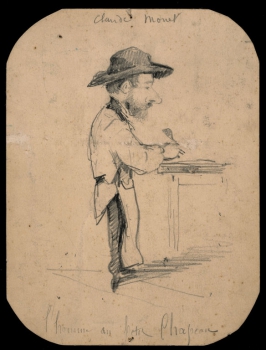Claude Monet, ‘L’homme au petit chapeau’ (The Man in the Small Hat) 1855/56, Art Institute of Chicago.
Monet started his career as a caricaturist. The Art Institute of Chicago keeps one of his most ancient drawings, this man in a small hat made when he was 15 years old. Because the title is so vague and the drawing rather respectful, we can imagine that this young person may have been Monet’s school mate. Later on, Monet became more offending by drawing what was not yet called the people of Le Havre, as we say in French: the upper middle class bourgeoisie of his city.
I must say this is not the Monet I like best. But it reflects the impulsive and rebellious personality of the painter. Twenty years later, it was Monet’s turn to be mocked, when he dared show his avant garde paintings at the first impressionist exhibition in Paris.
This is how liberty goes. Monet and his friends opened new fields of liberty. The freedom to paint how I like, what I like. The freedom to exhibit and find buyers.
But Monet wanted more. Later on Monet still fought for the admission of Manet’s ‘Olympia’ in the state collections. He didn’t paint for a year to dedicate to this mission. He wanted public recognition of this new freedom.
In matter of politics, Monet was not the kind of artist that withdraws in one’s studio. He was friend with Zola and supported him during the Dreyfus Affair, because he felt things were not fair and had much to do with anti-semitism.
This is how he lived, secluded in the village of Giverny but reading the newspapers, keeping an eye on the world, speaking with Clemenceau.
Monet would have been Charlie.
